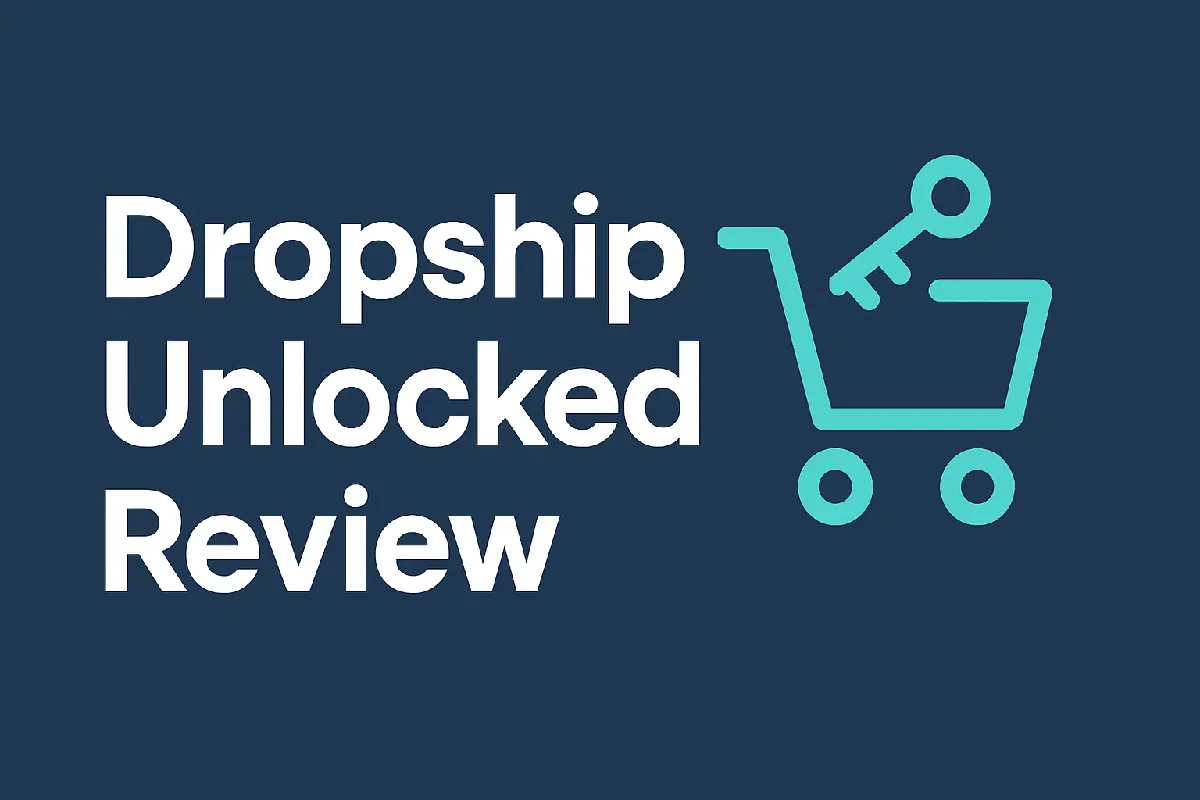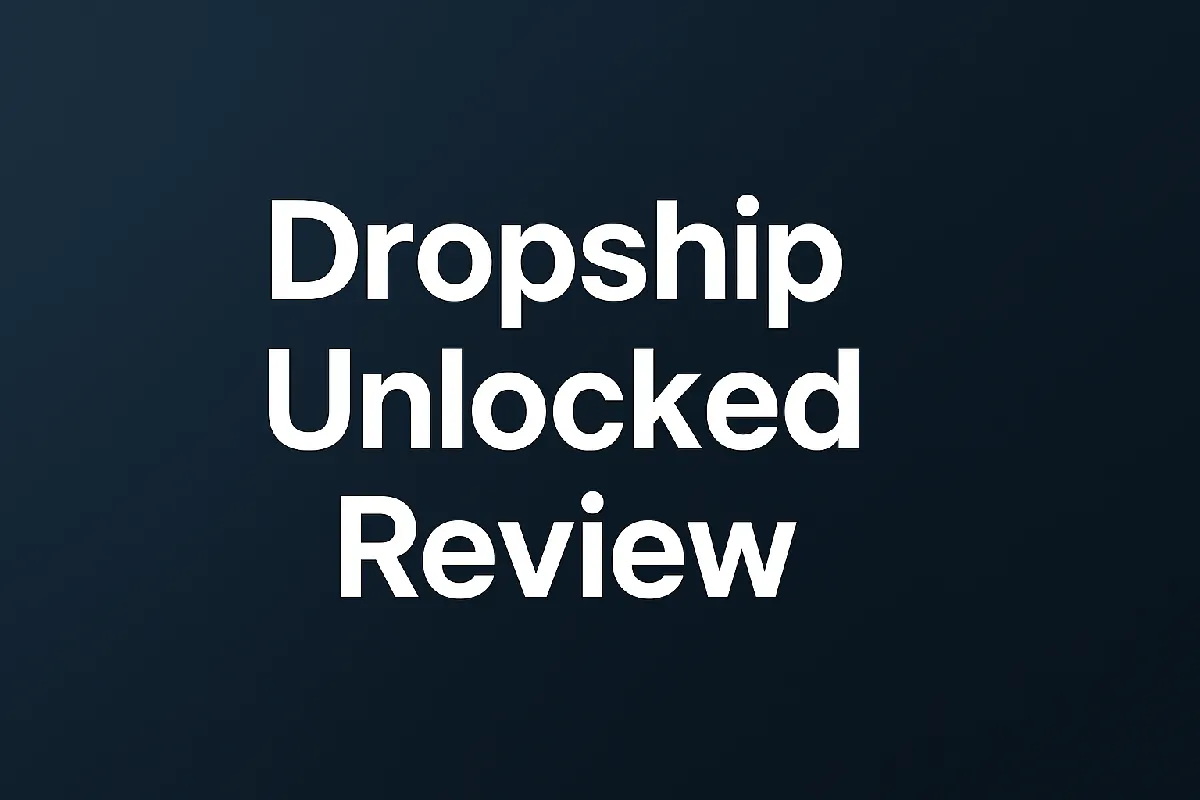Dropship Unlocked Review - Here's What To Expect From This High Ticket eCommerce Program
Welcome to this Dropship Unlocked review. This program is marketed as a step-by-step system for building a high-ticket dropshipping business, particularly aimed at people in the UK.
The idea is to help students partner with domestic suppliers to sell premium products online — avoiding long shipping times and unreliable overseas suppliers.

The course is structured as a six-week masterclass with additional mentorship and community support.
It promises to guide you from product selection to supplier outreach, store setup, and scaling through ads.
The presentation makes it sound beginner-friendly, but the entry barrier is high, with reported costs running into several thousand pounds once accepted into the full program.
The strengths lie in the structure, the regional focus, and the community aspect.
For UK-based entrepreneurs who want localized training, it’s a more tailored alternative to generic dropshipping courses.
But the lack of transparent pricing, the upsell process, and the mixed student outcomes all make it something that requires careful consideration before jumping in.
Pros
UK-focused approach to dropshipping
Step-by-step structure and live coaching
Supportive community and clear supplier strategy
Cons
High, undisclosed cost until application
Heavily upsold backend offers
Student results vary widely
The tricky part isn’t finding a program that sounds good — it’s spotting the difference between systems that build real income and those that quietly drain it. I’ve unpacked that difference here.
What is Dropship Unlocked?
This program is framed as a complete system for building a high-ticket dropshipping business — specifically focused on the UK market.
The promise is to teach students how to identify profitable products, partner with domestic suppliers, and create branded online stores that sell premium items.
The appeal lies in moving away from low-cost, overseas shipping models and toward something more sustainable, with faster delivery and higher margins.
Inside, the training is divided into modules that walk through product research, supplier outreach, website setup, marketing, and scaling.
Each stage includes templates, scripts, and examples designed to simplify the process for beginners.
There’s also a private community, live Q&A calls, and ongoing mentorship sessions, all presented as ways to make the journey less overwhelming.
The marketing message focuses heavily on freedom — financial, geographic, and time-based.
The idea is that by building a store around higher-priced products, fewer sales are needed to hit profit goals.
It’s positioned as a “smarter” alternative to traditional e-commerce models that rely on volume and razor-thin margins.
However, it’s worth noting that access to the full program isn’t instant. Interested students go through an application or interview process before being told the price or invited to join.
That process, along with the lack of upfront transparency, gives it more of a coaching program feel than a standard course.
My Personal Experience With Dropship Unlocked

Going through this program gave me a mix of structure and uncertainty. On one hand, the training was well-organized.
Each module felt intentional, guiding me from niche selection to contacting suppliers and building out a store.
The process itself wasn’t confusing — it was just a lot more detailed than the promotional material made it seem.
The idea of selling high-ticket items instead of cheap gadgets made sense, and the focus on local suppliers was a refreshing angle.
What stood out most was the pacing. It’s presented as a six-week roadmap, but realistically, it took longer to get things moving.
Finding reliable suppliers took patience, and even with templates and scripts, it still required negotiation and persistence.
I also noticed that many of the tools and systems they recommended added extra monthly costs — hosting, apps, ads, and software subscriptions — that weren’t clearly mentioned upfront.
The community was active and supportive, which helped, but results varied widely among members.
Some managed to land supplier deals early on and start selling, while others struggled to find products that fit the criteria.
I fell somewhere in between — the learning curve wasn’t impossible, but the expenses and time investment made progress slower than expected.
What I took away from the experience was that the system itself isn’t broken — it’s just not as plug-and-play as it sounds.
Success required more capital, experimentation, and resilience than I initially planned for.
What this experience showed me is that the biggest challenge isn’t following the steps — it’s knowing what to expect before you start. I’ve outlined that in more detail here.
How Much Does Dropship Unlocked Cost and What's The Refund Policy?
The pricing was one of the first surprises I ran into. The program doesn’t list any costs publicly, and you only learn the price after applying and speaking with someone from the team.
When I finally reached that point, I was quoted just over £3,000 for full access, with options to split the payment into installments.
That’s a serious commitment for most people, especially when factoring in the additional expenses that come after enrollment.
Those extra costs add up quickly. Beyond the tuition, I found myself paying for website hosting, e-commerce tools, paid ads, and optional coaching upgrades.
By the time everything was running, the overall investment was far higher than expected.
The program positions this as part of building a “real business,” but it’s important to understand that success here relies on continued spending, not just learning.
As for refunds, the terms were a bit restrictive. The policy required students to prove they had gone through the modules, completed all assigned work, and implemented specific steps before being considered eligible.
In other words, you had to fully commit before even qualifying to request a refund, which made the guarantee feel more like a formality than an actual safety net.
The structure and content had value, but the financial side required more preparation than the marketing implied.
Going in without a solid budget can make the experience stressful, especially when ad costs fluctuate and results take time.
Dropship Unlocked Student Results and Testimonials
The results I saw across the community were mixed — some success stories, plenty of slow starts, and quite a few people who eventually went quiet.
Inside the group, a handful of students did post encouraging updates. They shared screenshots of their first sales or early supplier deals, which showed that the process can work when everything lines up.
Those wins gave the program a sense of momentum and proved that it wasn’t just theoretical.
At the same time, it was hard to ignore how uneven those outcomes were. Many others were still stuck at the product research or supplier negotiation stage, even weeks or months in.
A few mentioned that after spending heavily on ads, they were barely breaking even.
It created a clear contrast — for every visible success story, there were several people still trying to get traction.
From what I experienced, the results depended less on the system itself and more on each person’s budget, persistence, and ability to adapt.
The training provided the tools, but not every student had the same resources or time to use them effectively.
I also noticed that the most polished testimonials — the ones shared in marketing materials — tended to highlight best-case scenarios rather than the full range of experiences within the group.
Overall, it was clear that results were possible, but far from guaranteed. The success stories were real but represented a small portion of the total picture.
Most people seemed to walk away with knowledge rather than profit.
Dropship Unlocked Pros and Cons
There’s no question that the program is polished. The structure is one of its biggest strengths — everything is broken into clear stages, and the focus on high-ticket products gives it a more strategic feel than most entry-level dropshipping courses.
The inclusion of supplier outreach scripts, store templates, and live coaching helps make the process feel manageable, even for beginners.
I also appreciated how tailored it was for the UK market, since most dropshipping programs are built around US suppliers and logistics.
The support community is another strong point. Having a place to ask questions, share updates, and see what others are building made the experience less isolating.
The mentorship aspect gave the training a personal touch, and the team seemed responsive whenever questions came up during live sessions.
For someone new to e-commerce, that kind of support can make a big difference in confidence and follow-through.
The downsides were mostly tied to money and expectations. The tuition alone was expensive, and once advertising costs and software tools came into play, it became clear that this was more of a long-term investment than an entry-level course.
The lack of upfront pricing added unnecessary pressure — you had to commit to a call before even finding out the real cost.
And while the marketing promised predictable success, most students I interacted with were still struggling to hit consistent numbers.
The material is legitimate, but the real challenge lies in how much time, money, and persistence it demands to see meaningful results.
Final Verdict
After going through the program and seeing how others fared, I’d describe Dropship Unlocked as a well-built but demanding system.
It gives you a clear roadmap for starting a high-ticket dropshipping business, but it also requires more financial and personal commitment than most people expect going in.
The step-by-step process, live support, and focus on UK suppliers make it one of the more structured options out there — but structure alone doesn’t guarantee results.
For those with a strong budget and a willingness to put in the work, it can provide a solid foundation to build from.
But for anyone hoping for a low-cost, plug-and-play route into e-commerce, this isn’t it.
The real effort starts after the course ends, when you’re juggling supplier relationships, ad campaigns, and fluctuating margins.
That’s the part most marketing glosses over — the business side that requires daily attention and ongoing reinvestment.
The bottom line is that it’s not an outright red flag, but it’s also not a magic bullet.
The information is solid, but the execution determines everything. Going in with realistic expectations and enough capital makes all the difference in whether this turns into a functioning business or another expensive lesson.
It’s easy to chase the next big opportunity — harder to know which ones actually lead somewhere. You can see how to tell the difference here.